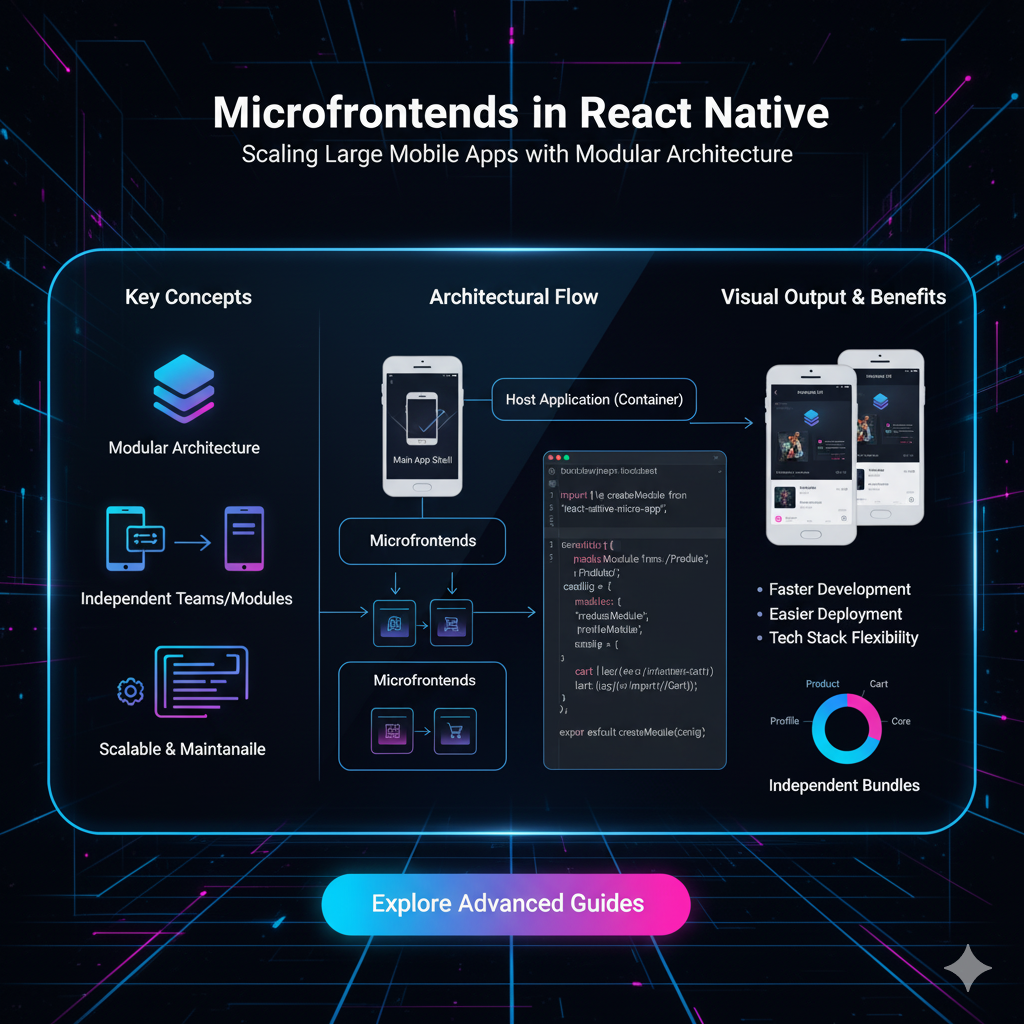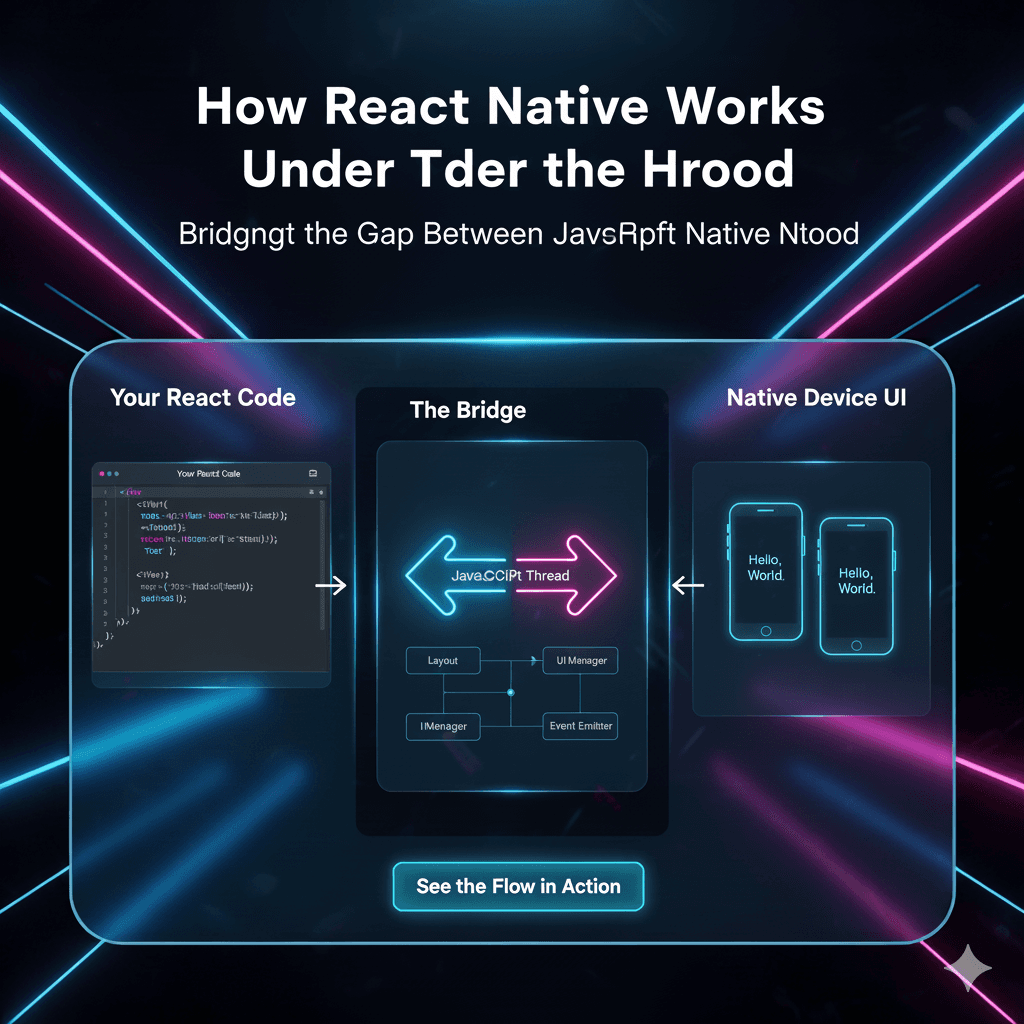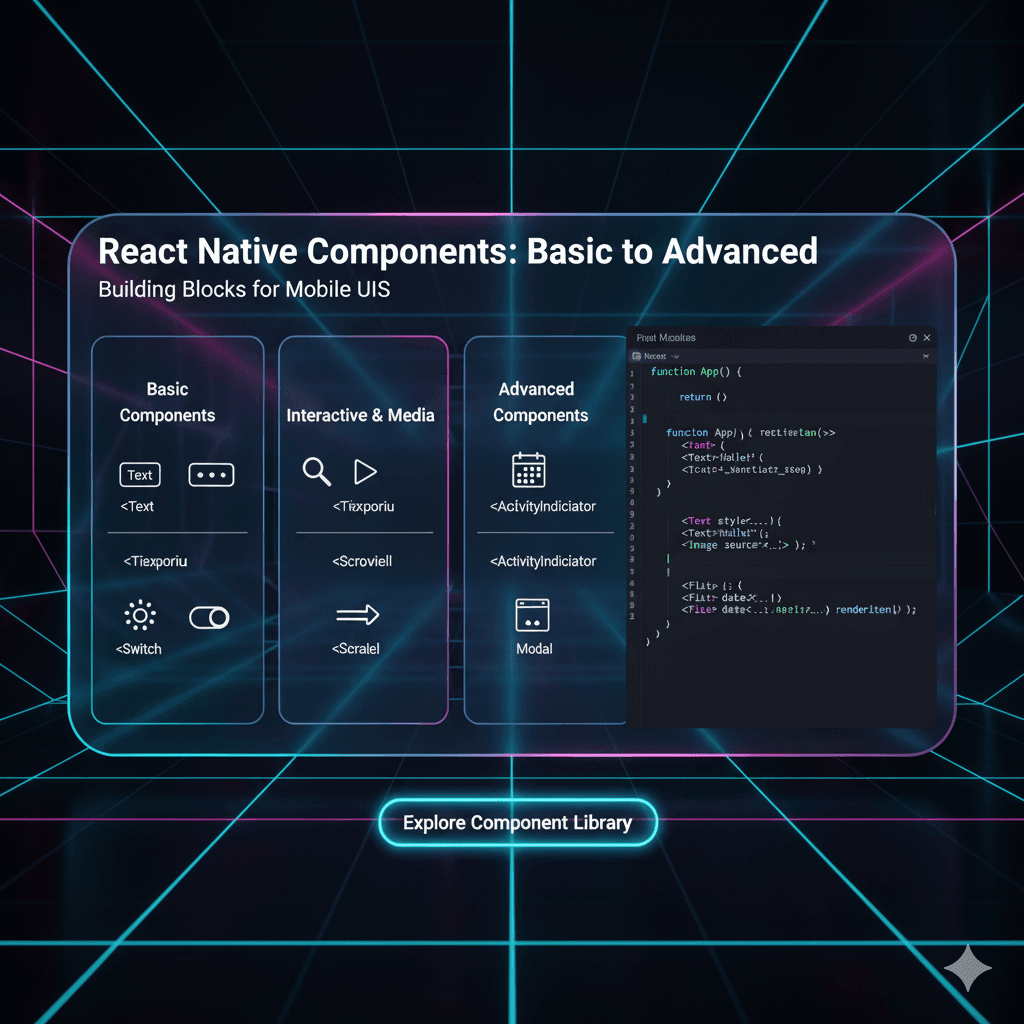Microfrontends in React Native: The Ultimate Guide to Scaling Mobile Apps

Tired of giant, slow mobile codebases? Learn how Microfrontends in React Native can help you scale your team and app. Get examples, best practices, and real-world use cases. Level up your skills with CoderCrafter!

Microfrontends in React Native: The Ultimate Guide to Scaling Mobile Apps
Taming the Beast: How Microfrontends in React Native Can Save Your Sanity (and Your Codebase)
Let's be real. Building a mobile app is exciting... until it isn't.
You start with a clean, beautiful codebase. A few features in, everything's still manageable. But then, your app hits it big. The product team has a million new ideas, you need to onboard more developers, and suddenly, your once-tidy React Native project has morphed into a gigantic, tangled monolith.
Sound familiar? You’re not alone. Every successful app hits this scaling wall. A tiny change in the payment flow somehow breaks the user profile page. Deployments become a nerve-wracking, all-hands-on-deck event. And don't even get me started on the "dependency hell."
So, what's the move? If you're a web developer, you've probably heard of Microservices—breaking a giant backend into smaller, independent services. Well, folks, that same philosophy has come to the frontend, and it's a game-changer for mobile too.
Welcome to the world of Microfrontends in React Native.
Alright, But What Are Microfrontends? (No Jargon, Please)
Think of your app not as a single, massive entity, but as a collection of smaller, self-contained apps. Each of these mini-apps is a Microfrontend.
A Microfrontend is an architectural style where a frontend app is decomposed into individual, semi-independent "microapps" working loosely together. Each one owns a distinct feature or business domain.
In the context of React Native:
The "Product Catalog" could be one Microfrontend, built and maintained by Team A.
The "Shopping Cart & Checkout" could be another, managed by Team B.
The "User Profile & Settings" could be a third, handled by Team C.
These individual pieces are then composed into a single, cohesive mobile application that feels seamless to the user.
Why Would You Even Bother? The Real-World Perks
This isn't just some theoretical hype. The benefits are legit and directly tackle the pains of a large codebase.
Team Autonomy & Scaling: This is the big one. Teams can work independently. Team B can ship updates to the checkout flow every day without needing to coordinate with Team A, who's working on the product search. It’s a massive boost for developer velocity and morale.
Technology Agnosticism (Within Reason): While you're likely using React Native across the board, different Microfrontends could be written in different versions of React or use different state management libraries. This allows for incremental upgrades and reduces the fear of "we can't use that new library because it'll break the whole app."
Simplified, Focused Codebases: A developer working on the "Notifications" Microfrontend only needs to understand that specific part of the app. The cognitive load plummets. New hires can become productive much faster.
Independent Deployment: This is the holy grail. You can deploy a single feature without rebuilding and redeploying the entire application. Tools like CodePush make this even more powerful, allowing you to push updates directly to users' phones.
The Flip Side: It's Not All Rainbows and Unicorns
Before you go and refactor your entire app tomorrow, pump the brakes. Microfrontends introduce their own set of complexities.
Operational Overhead: You're now managing multiple repositories, CI/CD pipelines, and potentially even more complex testing strategies.
Bundle Size Concerns: If not done carefully, you can end up with duplicate dependencies (like multiple copies of React) across Microfrontends, bloating your final app size.
Communication is Key: How do these isolated pieces talk to each other? You need a robust strategy for cross-microfrontend communication (e.g., a global event bus, or state managed at the shell app level).
Consistent UI/UX: Ensuring the app feels like one unified product and not a Frankenstein's monster of different styles requires strong design systems and shared component libraries.
How Does This Magic Actually Work in React Native?
The core idea revolves around a "Host" or "Shell" application. This shell is the container that's responsible for:
Bootstrapping the app.
Providing the native navigation (e.g., using React Navigation).
Loading and rendering the correct Microfrontend at the right time.
The individual Microfrontends are often built as separate React Native libraries or packages. The host app then dynamically loads these packages.
Let's visualize a simple example: A E-commerce App.
The Shell App (The Conductor):
Sets up the main
Tab.Navigator.Has a
HomeScreen, but the content is dynamically loaded.Handles deep linking.
Microfrontend 1: @product-catalog (Team A)
Exports a
ProductListScreencomponent.Exports a
ProductDetailScreencomponent.Managed in its own Git repo.
Microfrontend 2: @user-profile (Team B)
Exports a
ProfileScreencomponent.Exports a
OrderHistoryScreencomponent.Managed in its own Git repo.
The shell app's package.json would list these as dependencies:
json
{
"name": "AwesomeStoreShell",
"dependencies": {
"@product-catalog": "git+https://...",
"@user-profile": "git+https://...",
"react-navigation": "..."
}
}And in the shell's navigation setup:
javascript
// In App.js of the Shell
import { createNativeStackNavigator } from '@react-navigation/native-stack';
// Import from the microfrontends
import { ProductListScreen, ProductDetailScreen } from '@product-catalog';
import { ProfileScreen } from '@user-profile';
const Stack = createNativeStackNavigator();
function App() {
return (
<NavigationContainer>
<Stack.Navigator>
<Stack.Screen name="Products" component={ProductListScreen} />
<Stack.Screen name="ProductDetails" component={ProductDetailScreen} />
<Stack.Screen name="Profile" component={ProfileScreen} />
</Stack.Navigator>
</NavigationContainer>
);
}For more advanced, truly dynamic scenarios, you might use module federation (with tools like @module-federation/react-native) or other dynamic import techniques to load Microfrontends at runtime, even over-the-air.
Real-World Use Cases: Who's Actually Doing This?
You won't see a lot of public case studies for React Native specifically, but the pattern is gaining traction, especially in large-scale organizations.
Large E-commerce Platforms: Imagine Amazon's app. The product page, the recommendation engine, the reviews section, and the 1-Click ordering could all be separate Microfrontends owned by different teams, all shipping updates independently.
Super Apps & Banking Apps: Apps like Grab, GoJek, or large banks have dozens of features (Food Delivery, Ride Hailing, Payments, Investments). Each of these verticals can be a Microfrontend, allowing them to scale and experiment rapidly.
Enterprises with Multiple Product Lines: A company offering a suite of business tools (CRM, HR, Accounting) could build the shell once and have different teams develop each product as a Microfrontend.
Best Practices to Keep You From Going Crazy
If you're going down this path, do it right.
Establish a Strong Design System: Create a shared UI component library (buttons, inputs, typography) that all Microfrontends must use. This is non-negotiable for consistency.
Define Clear APIs and Contracts: How will the shell and microfrontends communicate? How will data be passed? Document this rigorously.
Start with a Monorepo (Maybe): Tools like Nx or Yarn Workspaces allow you to have multiple packages in a single repository. This simplifies dependency management and code sharing in the early stages.
Invest in CI/CD from Day One: Automate everything. Linting, testing, building, and deploying each Microfrontend should be a seamless process.
Version Your Microfrontends: The shell should specify which version of a Microfrontend it uses. This prevents a bad deploy from breaking the entire app.
FAQs: Quick Fire Round
Q: Can I use Microfrontends with Expo?
A: It's tricky, especially with the "bare" workflow, but with the classic Expo managed workflow, it's very difficult due to the build process. You'll have more flexibility with a bare React Native project.
Q: Is this for every React Native app?
A: Absolutely not. If you have a small team and a relatively simple app, this is over-engineering and will slow you down. This is a pattern for scaling large, complex applications with multiple, autonomous teams.
Q: What about app performance?
A: There can be a initial load-time hit if you're dynamically loading bundles. However, you can achieve better perceived performance by lazy-loading non-critical parts of your app. It's a trade-off.
Q: How do I handle shared state (like user authentication)?
A: The shell app should own truly global state. It can then pass this state down to the Microfrontends via props or a context that's set up at the shell level.
Wrapping It Up: Is It Worth The Hype?
Microfrontends in React Native aren't a silver bullet. They solve the complex problem of scaling frontend development for large organizations, but they introduce a new layer of architectural complexity.
The bottom line? If your app is built by a single, small team and is working fine, stick with the monolith. But if you're feeling the pain of a tangled codebase, slow feature releases, and tangled team dependencies, then exploring Microfrontends could be the strategic move that future-proofs your mobile development for years to come.
It's about giving your teams the autonomy to move fast, without breaking things for everyone else.
Ready to Master Modern Software Development?
The world of software architecture is evolving fast, and understanding patterns like Microfrontends is what sets top-tier developers apart. If you're looking to build a rock-solid foundation in full-stack development and learn in-demand skills from industry experts, we've got you covered.
To learn professional software development courses such as Python Programming, Full Stack Development, and MERN Stack, visit and enroll today at codercrafter.in. Dive deep into the technologies and architectures that power today's most successful applications. Your journey to becoming a senior-level developer starts here









